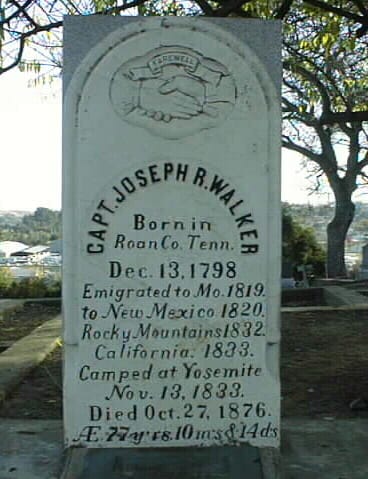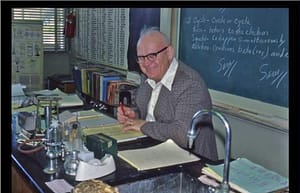Captain Joseph Walker was a pioneer, trailblazer, explorer, and mountain man. He was honorable, kind and courageous. The love of his life was adventure and exploring unknown territories. He was born on December 13, 1798 in Knoxville, Roane County, Tennessee.
Joseph Walker’s true adventures started at the age of 16 when his brother Joel, cousin Sam Houston and other family members joined the Tennessee Volunteer Mounted Gunmen (Tennessee militia). He served under General Andrew Jackson during the Creek War of 1813-1814 and participated in the Battle of Horseshoe Bend. Jackson and Walker remained friends until the death of Jackson in 1845.
In 1818, Joseph Walker’s family migrated to Fort Osage, a trading post built in 1808 by William Clark (Lewis & Clark) for the protection of the Osage Indians. (Fort Osage formally was closed in 1822 but remained a transit point for supplies going north on the Santa Fe Trail.)
Urged by Lewis and Clark, Captain Joseph Walker decided to try and reach the Pacific Coast at the age of 23.
Always the adventurer, Joseph Walker arrived in Spanish-owned Santa Fe, New Mexico in the summer of 1820. He tried to get to the Pacific Coast by the way of New Mexico. Unfortunately, the governor at the time was not in favor and he was jailed for being a possible spy for Andrew Jackson. Once released through a deal, Walker returned to Fort Osage, Missouri.
Walker often went to New Mexico via a government road that went from Missouri to New Mexico. On one return to Fort Osage with furs, he crossed paths with William Becknell. Becknell had been frustrated for weeks trying to figure a way through the mountains with three full wagons of goods.
Walker had often led emigrant wagon trains to New Mexico, Utah and Oregon. Being one who is always up for a challenge, Walker helped Becknell through his wagon route near the Cimarron River in Oklahoma, which extends across New Mexico. Due to Walker’s help, Becknell was able to sell his goods at a large profit in New Mexico.
In 1825, Walker was asked by the government to guide surveyors to assess a government road that was familiar to him. He was also asked to select a new town site at the request of the Missouri Governor. After his job with the surveyors was complete, he returned to Missouri. While on his way, he found the town site and named it Independence (after the Declaration of Independence). The government road became the Santa Fe Trail.
Walker became the first sheriff of Independence for two terms, during which time no murders were committed. While he was sheriff, he ran across a runaway indentured servant named Christopher Carson. Instead of returning the boy to the saddle maker, Walker turned the boy over to his friend, Ewing Young, who nicknamed the boy Kit and taught him to trap.
In 1832, Walker was introduced to Captain Bonneville at Fort Osage. Bonneville was Captain of the U. S. Infantry and was on a mission to explore the Rocky Mountains and beyond. Walker looked at this as his chance to reach the Pacific Coast and became Bonneville’s sub-leader.
After his first attempt to find the Pacific Coast (being sent to Utah by Bonneville), he tried again. This time he followed the Humbolt River. During the attempt, he came upon a gorge where he could see peaks and domes of a glacier cut valley. However, he did not go down as his half-starved men were in no condition to tackle hostile Indians in their territory. At the time Walker had no idea that he was the first Anglo American to see Yosemite.
In 1880, when Dr. Bonnell published his account of the Discovery of Yosemite, he recalls, “On one occasion I told him that Tanaya had said that a small party of white men once crossed the mountains on the north side, but were so guided as not to see the valley… With a smile the captain replied, ‘That was my party, but I was not deceived, for the lay of the land showed that there was a valley below; but we had become nearly barefooted. our animals poor, and ourselves on the verge of starvation. So, we followed down the ridge to Bull Creek where Kelly killed a deer, and there we camped.'”
Walker continued to reach the Pacific Coast by descending to the San Joaquin Valley, crossing the coast range, and finally coming to Monterey. He had finally reached his dream – the Pacific Ocean.
In 1846, he served as a guide for Charles Fremont’s expedition in California. Fremont had unfurled an American flag atop Hawks Peak in the Gabilan Mountains, belonging to Mexico. Fremont retreated when Mexican troops assembled, leaving Walker and his men vulnerable. Walker quit Fremont in utter disgust and never had a good word to say about him after that. He exclaimed, “He (Fremont) was the greatest moral and physical coward I ever met”. Adding, “I would call him a woman, if it weren’t a slur to the sex.”
At age 65, General Carlton (a long-time friend), asked Walker to capture Mangas Coloradas, the great Chief of the Mimbreno Apaches. Chief Mangas had overrun the Pino Alto gold mines in New Mexico. If the chief could be captured, it would open up the gold mines for the United States.
Captain Walker, with a young Indian boy named Pena, led a party of men into New Mexico, capturing the Apache Chief. They had lured the chief into their camp on the pretext of offering him valuable trade goods. After finishing the request, Walker continued on to the Tucson, Arizona gold mines. Soldiers murdered Chief Mangas, but the Walker party had passed unharmed through Apache territory before news of this atrocity reached Mangas’ followers.
Losing his eyesight, he retired to the Manzanita Ranch (his nephew’s) in Ygnacio Valley. Captain Joseph Walker passed on October 27, 1876. Walker Pass, Walker Lake, Walker River, Walker Valley, Walker Gulch, Walker Canyon, Walker Creek, Walker Trail, Walker Peak, Walker Mining District, Walker, Ariz., and Walker, Calif. are all named for him.
The original content of this post was taken from the previous website and updated for republishing in 2021.
Updated information was taken from the Stockton Daily Evening Record in 1923 and “Westering Walker” by Kate Ruland-Thorne, the author of “Gold, Creed and Glory”. in 2009.


